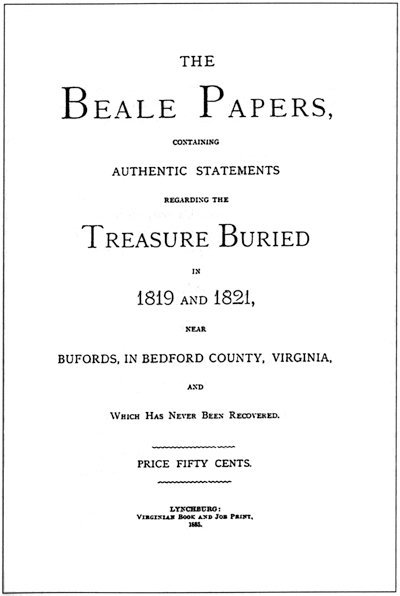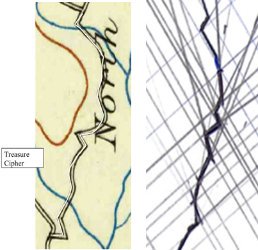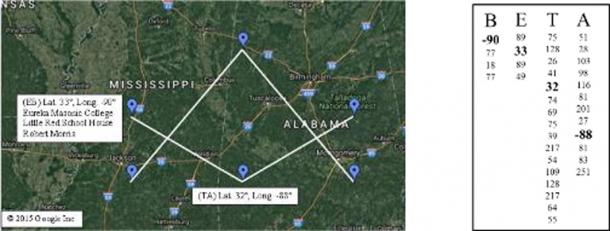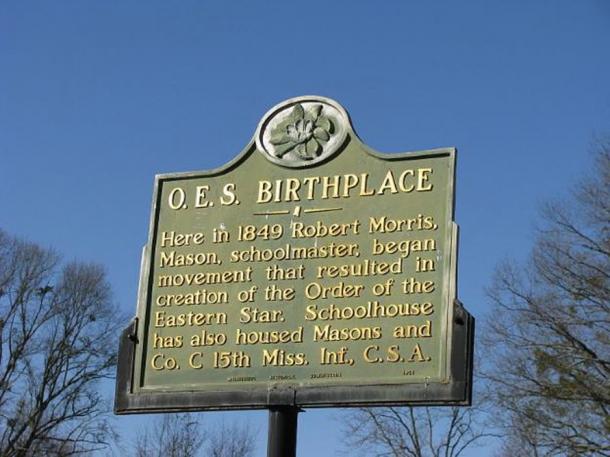A view of Bedford County, Va., where the supposed treasure of “The Beale Papers” is said to be buried . ( CC BY 3.0 )
Beale left behind three encrypted pages with an innkeeper named Robert Morriss. The Beale Ciphers told of an associate of Beale’s who would return to Bufordville with a key to decrypt the encrypted pages and claim the treasure. The associate never arrived. The three encrypted pages are described as containing the location of the treasure, the names of the relatives of the miners, and the contents of the buried treasure. In 1885 the three ciphers were sold to the public as The Beale Papers .

Cover of ‘The Beale Papers’. ( Public Domain )
Beale’s Treasure a Freemason’s Tale author Dan Mento, a woodshop teacher taking a break from grading his student’s measurement assignments and looking for a short distraction, encountered the mystery of Beale Papers on the internet. He read a summary of the Beale Ciphers and was intrigued. He printed a copy of the Treasure Cipher also known as C1.

Finding Coordinates
Mento’s first impressions led him to process the numbers from C1 as road bearings and distance surveyor coordinates. The plotting process produced a graphical representation that looked to be a road or river traveling in a North Easterly direction. Fascinated by the results, Mento located a map of Montvale, Virginia. Montvale, formerly known as Bufordville, was where the suspected Beale treasure was to have been buried. After he searched the map for a North Easterly road or river, he identified North Goose Creek as a possible match.
Since more than 180 years had passed, he needed to find an older map. Mento found an 1891 topographical map of Roanoke, Virginia and looked closely at the Bufordville section of the map, which revealed a road that was a near perfect match to the graphical representation that he had drawn from the Treasure Cipher. Mento acknowledged that he was onto something and devised a method for accurately plotting the surveyor data from the treasure cipher onto the 1891 topographical map.
Mento eventually recognized that the three encrypted pages (the Treasure Cipher C1, Solved Cipher C2, and the Names Cipher C3) all contained surveyor coordinates. Plotting the coordinates of the three ciphers, he found that they precisely matched three intersecting roads that converged at an equilateral triangle turn from the 1891 topographical map of Roanoke, Virginia. Mento assumed the encrypted surveyor’s bearings and distance coordinates would have had to come from a surveyor’s notebook most likely supplied by James B. Ward, who was the printer of Beale Papers , a Freemason, and a county surveyor.

The Treasure Cipher C1, Solved Cipher C2, and the Names Cipher C3. (Author provided)
The Beale Papers stated that the Solved Cipher C2 was solved by transposing the numbers from C2 to letters using the Declaration of Independence. The transcription of C2 told of gold ore, silver ore, and jewels that had been buried. Mento imagined the possibility that the bearings and distance numbers served a dual purpose and also could be transposed to words.
Anagrams and Acronyms
He decrypted the road surveyor bearings and distance numbers to letters using the Declaration of Independence. This revealed over 30 four-letter anagrams and acronyms relating to Freemasonry. The likes of OATH, AIMA, IOTA, ETON, WIFE, WAGE, MADE, GATE, EAST, INCA, IPSE, FORT, IBIS, NAOS, SION, ORIO, EAAA “Entered Apprentice Ancient and Accepted,” ATRA “American Templar Royal Arch,” and OBDT “Obedient Servant” are found within C1, C2, and C3 road bearings and distance numbers.
Additionally, Mento discovered that each of the three cipher pages contained embedded fields of numbers that lacked plottable road bearings. C1 contains one field, C2 contains three fields, and C3 contains two fields. The six embedded fields are symmetrically located in each of the three cipher pages.

Name Cipher Field One numbers transposed from the Declaration of Independence. (Author provided)
Masonic Symbols Emerge
Within the six embedded fields, Mento found the presence of four-letter anagrams that also have latitude and longitude coordinates. When the coordinates are plotted, they form part of the Freemason square and compasses. The square and compasses are located all over the world linking ancient lands to what the Freemasons claim as their legacy. Five of the six embedded fields contained large anagrams relating to Masonic dogma. Two other fields contain geometric letter notations that represent the Shield of David and the Order of the Eastern Star symbol.
The evidence that Freemason Dr. Robert Morris is the architect of Beale’s Ciphers is embedded within the first field of the Names Cipher or C3. The anagram BETA “meaning the second in line” was located in the first field.
The coordinates for BETA span between Mississippi and Alabama forming the left arm of the Freemasons square. The Mississippi latitude and longitude coordinates for BETA are located two miles from Eureka Masonic College also known as the Little Red Schoolhouse. Eureka Masonic College is where Dr. Robert Morris, its most famous educator, created the Order of the Eastern Star (OES).

The coordinates for BETA. (Author provided)
In 1884, 500,000 Freemason brothers voted Dr. Robert Morris to become the second Freemason Poet Laurette, coincidentally the Beale Papers were published and sold in 1885. The connection between Robert Morris and the OES led to an OES document entitled An Elaborate History of the Order of the Eastern Star by Jean M’Kee Kenaston.
An Elaborate History of the Order of the Eastern Star mentioned a Mary A. Beale as the Illinois Grand Secretary of the OES (1882-1891) and her husband George H. Beale, a 32nd Degree Mason. Both Mary and George spent over two years in Colorado while George fought consumption in the 1880’s prior to his death. The Beale Papers also identified Colorado as the location where the treasure was mined. An Elaborate History of the Order of the Eastern Star noted in the OES meeting minutes the processing of masonic materials that needed to be encrypted and distributed to its lodges and the originals destroyed.

Sign: Order of Eastern Star Birthplace. Eureka Masonic College (The Little Red School House) in Holmes County, Mississippi. (NatalieMaynor/ CC BY 2.0 )
A Freemason Story
The Committee on Foreign Correspondence (CFC) was uncovered as a twelve-letter anagram embedded at the end of the Treasure Cipher road bearings and distance numbers as CFC WITHSTOOD. The lodge duties of the Committee on Foreign Correspondence are to answer all communications with other lodges, record and report all yearly activities, maintain all lodge records, and perform research as directed – essentially this is the literary branch of the lodge system.
The story of Beale’s Treasure a Freemason’s Tale echoes the journey of discoveries in the order that Mento had found them. Beale’s Treasure a Freemason’s Tale presents an exacting narrative of methodologies used and the connections that each solution has to Masonic literature. Having finished Beale’s Treasure a Freemason’s Tale, the reader will conclude that there is no silver or gold treasure – only 19th century Freemasons.

Print of “Washington As Master Mason.” ( Public Domain )
VIA:
ancient-origins
Source Article from https://worldtruth.tv/does-cryptic-code-hidden-in-beale-ciphers-reveal-secrets-of-the-freemasons/
 RSS Feed
RSS Feed















 April 9th, 2018
April 9th, 2018  Awake Goy
Awake Goy  Posted in
Posted in  Tags:
Tags: 













